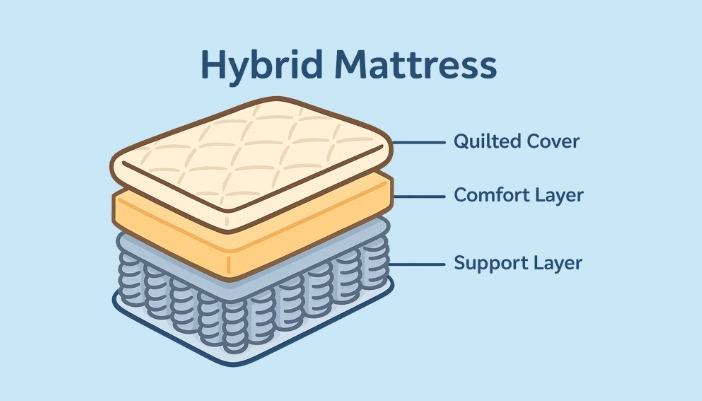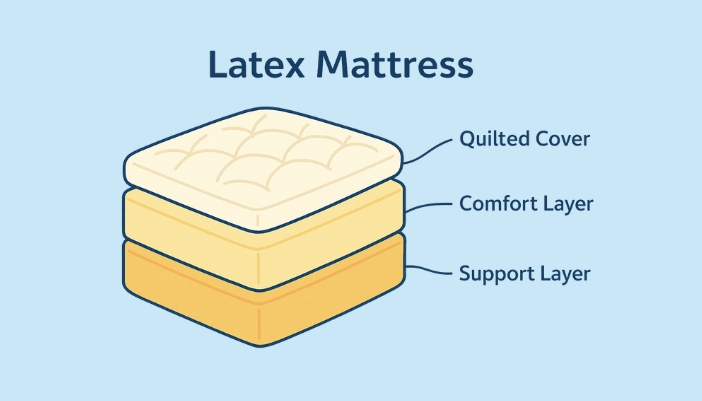Ever spent a night tossing and turning, convinced you bought the wrong mattress? Maybe it felt like a dream in the store, but it became a nightmare at home. That’s the frustrating reality when you don’t really know what’s inside your mattress, or how those hidden layers impact your sleep.
But here’s the thing: a mattress isn’t just a big, soft rectangle. It’s a carefully built stack of layers, each with a purpose. Some keep you cozy, some offer support, and some even work to keep you cool. Understanding what’s inside can mean the difference between waking up refreshed or waking up with an aching back.
Not sure where to start? That’s where our experts at Western Slope Appliance come in. But first, let’s pull back the cover and take a look at the layers and materials that make each mattress unique.
Mattress Types and Their Layers (with Key Materials)
Every mattress is more than just a big, comfy rectangle—it’s a carefully designed stack of layers, each with a job to do. Most mattresses come with a quilted cover for a soft, finished feel, but it’s what’s beneath that cover that really makes the difference!
So, let’s look inside some of the most common mattress types—what they’re made of and why it matters.
Innerspring Mattresses

Innerspring mattresses are the classics—the ones that probably come to mind when you think of an old-school bed. But don’t be fooled by their age; modern versions have come a long way, and their inner workings are far from basic.
At the heart of every innerspring mattress is its support system: coils. But not all coils are created equal, and the type of coil can change how the mattress feels and performs:
- Bonnell Coils: The most traditional option—hourglass-shaped, affordable, but slightly bouncy.
- Pocketed Coils: Individually wrapped coils that move independently mean less motion transfer when your partner moves.
- Continuous Coils: A single wire twisted into a series of springs—durable but less contouring.
Of course, it’s not just about the springs. The top of an innerspring mattress is all about comfort, and that’s where you’ll find the cushioning materials:
- Polyfoam: A budget-friendly option that adds a bit of softness.
- Fiber Padding: Light, breathable layers that add a plush feel without much support.
- Natural Options: Cotton or wool for breathability and a more eco-friendly touch.
What really defines an innerspring mattress is how these materials work together. Thicker steel coils provide a firmer, more supportive feel, while thinner coils create a softer, more flexible surface. The comfort layers can add softness but also impact how breathable the mattress feels—natural fibers like cotton stay cooler than dense foam.
Memory Foam Mattresses

Memory foam mattresses are famous for their contouring comfort—the way they hug your body, easing pressure on your shoulders, hips, and lower back. But that signature feel all starts with the right layers.
At the core of a memory foam mattress is the comfort layer—the plush, body-hugging surface that makes memory foam so recognizable. But not all memory foam is the same:
- Traditional Memory Foam: Soft and contouring, but known for trapping heat.
- Gel-Infused Foam: Memory foam blended with tiny gel beads to help with cooling. Perfect for hot sleepers who love that cradling feel.
- Copper or Graphite-Infused Foam: Specially designed to pull heat away without sacrificing that cozy, pressure-relieving softness.
But softness needs support, and that’s where the mattress's base comes in. Beneath the comfort layer is a high-density polyfoam—a sturdy base that keeps you from sinking too deeply, supports your spine, and ensures the mattress lasts.
Memory foam mattresses are all about balance—plush enough to relieve pressure, but with a solid base that keeps you comfortably supported.
Hybrid Mattresses

Hybrids are all about balance—the perfect mix of plush comfort and strong support. But what makes a hybrid stand out is how it combines those two elements.
At the surface, a hybrid starts with its comfort layer. This is where you’ll feel that initial softness and pressure relief:
- Memory Foam: For that body-hugging, contouring feel.
- Latex: Naturally bouncy, breathable, and slightly more responsive.
- Polyfoam: A budget-friendly option that can feel soft or slightly firmer, depending on its density.
But the real strength of a hybrid comes from its support system, which is all about the coils beneath:
- Individually Wrapped Coils (Pocketed Coils): Coils that move independently, which means better motion isolation, so you won’t feel your partner’s every move.
- Reinforced Edges (Optional): Some hybrids use thicker coils or dense foam around the edges for stronger support, so you can sit or sleep near the sides without sagging.
The beauty of a hybrid is in the balance—soft comfort on top with the bounce and support of coils below. It’s the best of both worlds, and the feel can vary based on the thickness and type of each layer.
Latex Mattresses

Latex mattresses are the eco-friendly champions of the mattress world—naturally breathable, supportive, and incredibly durable. But it’s not just about being green; it’s about comfort that lasts.
At the top of a latex mattress, you’ll find the comfort layer—soft, responsive, and bouncy. But even here, the type of latex can make a big difference:
- Talalay Latex: Light, airy, and slightly softer—great for a plush, pressure-relieving feel.
- Dunlop Latex: Denser, slightly firmer, and highly durable—ideal for those who want solid support.
But comfort is nothing without stability, and that’s where the base comes in:
- Dense Latex Core: A thicker, more supportive layer that prevents sagging and keeps your spine aligned.
- Alternate Base (Optional): Some latex mattresses use a foam or coil base for a slightly different feel, but the core idea is always solid support.
Latex isn’t just about feel—it’s naturally hypoallergenic, resistant to dust mites, mold, and mildew, and free from harmful chemicals. That makes it a popular choice for eco-conscious shoppers and anyone with allergies.
Additional Materials to Look For
Regardless of which mattress type you choose, you’ll probably come across a few common materials that promise to make your sleep experience even better:
- Cooling Components: If you’re a hot sleeper, look for gel infusions, phase-change materials, or breathable covers designed to pull heat away from your body.
- Eco-Friendly Components: Organic cotton, natural wool, and recycled steel for a more sustainable sleep environment.
- Fire Barriers: Most mattresses have a layer designed to meet safety standards. This layer can be natural (like wool) or synthetic (like fiberglass).

What to Consider When Choosing a Mattress
Now that you know what goes into a mattress, it’s time to make that information work for you. The layers and materials inside a mattress aren’t just there for show—they directly impact how comfortable, supportive, and cooling your bed will feel. But how do you know which combination is right for you?
Here are the key factors to consider:
Your Sleep Position
Your preferred sleep position plays a huge role in which mattress layers work best for you:
- Side Sleepers: Need extra cushioning for their shoulders and hips. Look for a mattress with a plush comfort layer—memory foam or latex is ideal.
- Back Sleepers: Require balanced support to maintain spine alignment. Medium-firm memory foam, hybrid, or latex mattresses work well.
- Stomach Sleepers: Need a firmer, more supportive surface to prevent sinking and maintain proper alignment. Innerspring or firm hybrid mattresses are best.
- Combination Sleepers: Benefit from a medium-firm mattress with a mix of comfort and support layers, like a hybrid.
Your Firmness Preference
Firmness is a mix of personal preference and body type, but it’s also influenced by the materials in your mattress:
- Soft (3-5/10): Memory foam and plush latex are great options for side sleepers or those who love a plush feel.
- Medium (6-7/10): A versatile choice for most sleep positions—hybrids and medium-firm memory foam work best.
- Firm (8-10/10): Best for stomach sleepers or anyone who needs strong support. Innerspring, firm hybrids, or dense latex fit the bill.
Choosing the right mattress isn’t just about picking one that looks good or fits your budget—it’s about matching the right layers and materials to your sleep needs. Think about your sleep position, temperature preferences, and any sensitivities, and use that as your guide.
When in doubt, remember: a great mattress is one that supports your body, keeps you comfortable, and helps you wake up feeling refreshed.
Your Best Sleep Starts Here
Finding the perfect mattress shouldn’t feel like a guessing game. But if you know what’s inside, you’re already ahead. Understanding the layers means understanding your comfort, whether that’s plush foam, breathable latex, or supportive coils.
Still not sure which one’s right for you? That’s what our experts at Western Slope Appliance are here for. They know mattresses inside and out (literally) and can help you make sense of all the options.
Have questions? Want to feel the difference for yourself? Stop in and shop our selection—your best night’s sleep is just a decision away.